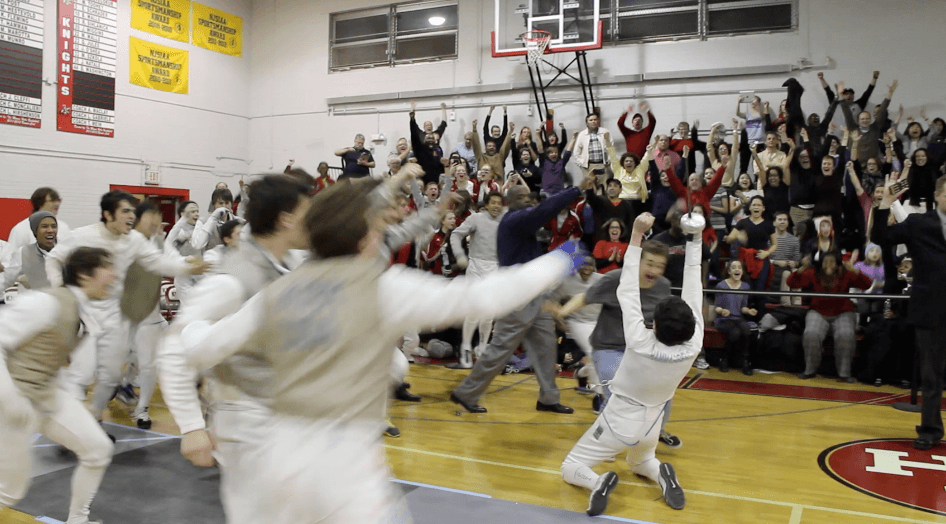The Future of Fencing: The Dual Meet Format

Victory at the NJISAA Team Championships. Photo Credit: fencingfortheedge.wordpress.com
The International Fencing Federation (FIE) has a stated goal of making fencing more audience friendly and many of the rule changes over the past 10-15 years have been made in this interest. This blog post is about two aspects of that, that I feel are generally overlooked – bout length and connection.
Generally speaking, people watch sports that they feel an emotional connection to and have a narrative they can get into. Individual fencing bouts satisfy neither of these needs for the casual viewer – few fencers are known outside the fencing community and a 10 minute DE match doesn’t give much time to engage on a visceral level. A possible solution that addresses these concerns is the dual meet.
Format
The dual meet format is used by the NCAA in intercollegiate competition. The premise is simple: there are men’s and women’s teams and each team has 3 squads – one per weapon. The individual squads are made up of 3 members. Each squad member fences each of the squad members from the other team for a total of 9 bouts. Each team is allowed one substitution[1].
This format gives 9 bouts each in foil, epee, and saber, for a total of 27 bouts between the schools. Whoever wins 14 or more is the victor. This leads to swings in the bout totals as the match progresses, creating interest, connection, and excitement. One team may suffer narrow losses of 4-5 and 3-6 in foil and epee, only to crush their rivals 7-2 in saber and snatch victory from defeat in the final match. With time for the excitement to build, the payoff is greater.
Each round starts fresh, so a team can choose who will compete at the beginning of each round. If they have 7 foilists, they can rotate through them in different rounds. This means that larger schools can rotate in newer fencers, either to crush schools they’re confident of beating, or as sacrificial lambs when they know they’ll lose.
Why Dual Meets
This format also gives a quick path to connection. While individual fencers are relatively obscure, a team would represent a larger, more known entity. A local league could be sponsored by local businesses, neighborhoods, or schools. Universities have alumni followings that will care if a rival is defeated. A meet like this would require one strip and could take place on a stage in front of seating.
Events similar to this occurred in the past involving multiple bouts between pairs of individual fencers, much like a boxing or mixed martial art competition does today. Fencing had famous fencers then, which it lacks now. Boxing matches largely are covered only when one of a handful of known boxers are fighting. MMA had a surge in popularity a few years back, but has seen TV ratings decline fairly steadily over the last year barring a few fights involving, you guessed it, the more famous fighters.
Tennis and golf have seen similar declines in ratings when they’ve lacked marquee players. By using known entities for teams, the dual meet format circumvents the lack of famous fencers and makes a quick connection to potential fans.
Logistics for Schools
The dual meet format has other benefits for a sport like fencing as well. This format allows multiple schools to gather in one location and hold successive meets with other schools. January 30-31, 2016, saw 18 schools compete at the Northwestern Duals in Evanston, IL, over 2 days. Each school would have potentially competed in up to 17 dual meets that weekend. Gathering this number of teams, referees, and other resources in one area allows a team to save on travel money, reduce the time lost from school or work, and reduce the costs associated from running an event by spreading it over more people. This allows teams from different areas to meet and compete with a common format.
Conclusion
The dual meet format has advantages for fencers, tournament organizers, and audience members. The teams can be seeded and meet order can be determined at the beginning of the day, so there are no periods in the tournament where the organizers are furiously entering data and checking numbers while the fencers sit around with nothing to do – data from one round can be entered while the next round is in progress. Fencers get more fencing and less downtime, and the downtime they do get is predictable – fencers and refs alike know when lunch will be and how long they have to eat (and, in the case of epee, nap). Audience members, be they parents, friends, alumni or casual passers-by, have an easier time finding the team they want to root for and following them throughout the day.
The other most common team formats try to take the structure of an individual tournament and apply it to teams of three people. But team events have their own needs and their own dynamics. They should have their own format, too.
[1] Each team has one person designated as a substitute who can be put in for a starter during an encounter. Once in, the sub stays in for the rest of the encounter. Once out, the starter is out for the remainder of that encounter.
